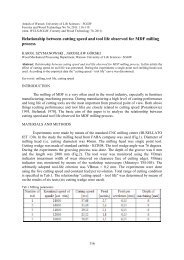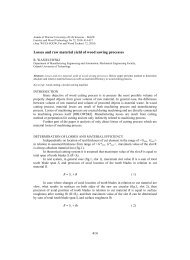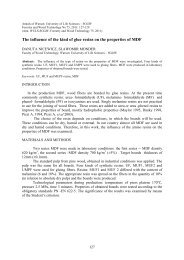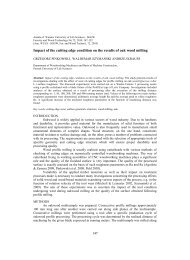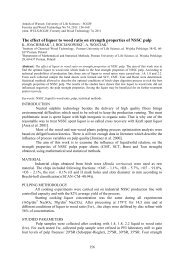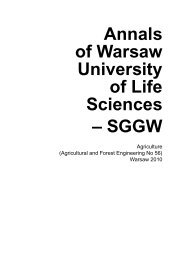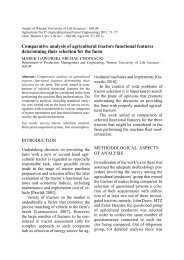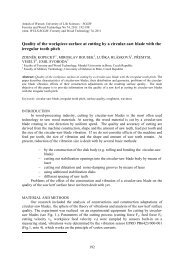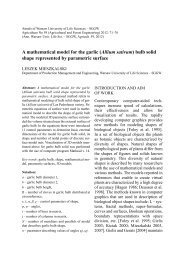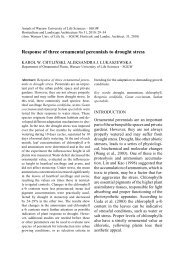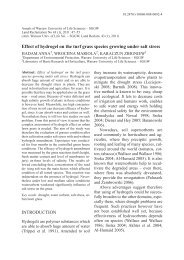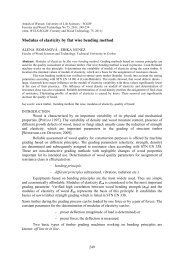Annals of Warsaw University of Life Sciences – SGGW. Animal ...
Annals of Warsaw University of Life Sciences – SGGW. Animal ...
Annals of Warsaw University of Life Sciences – SGGW. Animal ...
Create successful ePaper yourself
Turn your PDF publications into a flip-book with our unique Google optimized e-Paper software.
26 J. Gajewska et al.<br />
effect, e.g. L-carnitine used most <strong>of</strong>ten<br />
in flocks <strong>of</strong> breeding poultry, improving<br />
sperm concentration, hatchability and<br />
affecting production results (Zhai, 2008;<br />
Keralapurath et al., 2010; Shafey et al.,<br />
2010). Application <strong>of</strong> 20 to 100 mg per<br />
kg feed, L-carnitine in the nutrition <strong>of</strong><br />
poultry for slaughter allows for a reduction<br />
<strong>of</strong> fat content in carcass (Rabie et al.,<br />
1997a, b; Arslan et al., 2004). There are<br />
however, no reports on the effects <strong>of</strong> L-<br />
-carnitine on the composition <strong>of</strong> intestinal<br />
micr<strong>of</strong>lora <strong>of</strong> broiler chickens therefore<br />
Aminokarnifarm was used to because<br />
(43.68% <strong>of</strong> L-carnitine) to determine<br />
the composition <strong>of</strong> the micr<strong>of</strong>lora in the<br />
small intestine <strong>of</strong> chickens.<br />
MATERIALS AND METHODS<br />
The experiment was conducted in poultry<br />
farm <strong>of</strong> Experimental Station (RZD)<br />
Wilanów-Obory on 640 broiler chickens<br />
<strong>of</strong> COBB 500. One-day chicks were at<br />
random allocated to 2 groups: control<br />
and experimental (Aminokarnifarm), each<br />
<strong>of</strong> them in four repetitions. The birds<br />
were kept on the litter, according to the<br />
standards for management <strong>of</strong> broilers, as<br />
recommended by Cobb company. The<br />
differentiating factor was the administration<br />
<strong>of</strong> the group Aminokarnifarm<br />
to water for the experimental group <strong>of</strong><br />
chickens.<br />
Aminokarnifarm is a preparation<br />
amino acid vitamin, which a combination<br />
<strong>of</strong> vitamins and amino acids with taurine<br />
(13.33%) and L-carnitine (43.68%) has<br />
a very strong anabolic effects, improving<br />
production results. The preparation<br />
ensures the proper metabolism <strong>of</strong> fatty<br />
acids and amino acids, sufficient production<br />
<strong>of</strong> energy from ketones, regulation<br />
<strong>of</strong> concentration <strong>of</strong> ammonia in the<br />
blood, stimulation the immune system,<br />
the process <strong>of</strong> respiration and active<br />
transport <strong>of</strong> ATP at the cellular level.<br />
Composition <strong>of</strong> the preparation has a significant<br />
impact on the proper functioning<br />
<strong>of</strong> all systems in the body, in particular<br />
neurohormonal system, digestive, circulatory<br />
and reproductive. The presence <strong>of</strong><br />
L-carnitine determines the capacity <strong>of</strong><br />
the body, muscle strength, cardiac activity,<br />
in combination with the metabolism<br />
<strong>of</strong> amino acids enhances the whole body<br />
and neutralizes the negative effects <strong>of</strong><br />
various types <strong>of</strong> stress factors (Bi<strong>of</strong>aktor<br />
<strong>–</strong> producer information).<br />
Aminokarnifarm was added in drinking<br />
water in quantities <strong>of</strong> 100 g <strong>of</strong> the<br />
preparation <strong>of</strong> 160 liters <strong>of</strong> water, rearing<br />
on the following dates: 1<strong>–</strong>7 days, 21<strong>–</strong>28<br />
days, 35<strong>–</strong>42 days. During the rearing<br />
<strong>of</strong> chickens from the control group and<br />
experimental (Aminokarnifarm) were fed<br />
compound having the following nutritional<br />
value: Starter from 1 to 14 day<br />
(22.1% crude protein and 13.7 MJ <strong>of</strong><br />
EM). Grower from 15 to 35 day (20.4%<br />
crude protein and 14.1 MJ <strong>of</strong> EM).<br />
Finisher from 36 to 42 day (19.1%<br />
crude protein and 14.3 MJ EM, without<br />
coccidiostatic). On 42 day, from 9 males<br />
and 9 females, parts <strong>of</strong> intestinal were taken<br />
after slaughter. The aim was to determinations<br />
quantitative and qualitative factors<br />
<strong>of</strong> intestinal micr<strong>of</strong>lora in small intestine<br />
content <strong>of</strong> chicken broilers.<br />
Quantitative determination <strong>of</strong> small<br />
intestine content, received from two<br />
feeding groups, were done by standat<br />
Koch’s plate method, with surface sowing<br />
(Salyers, Whitt, 2003).<br />
The following microbiological rates<br />
were determined:



